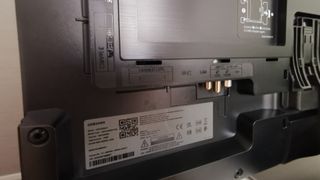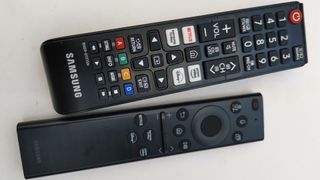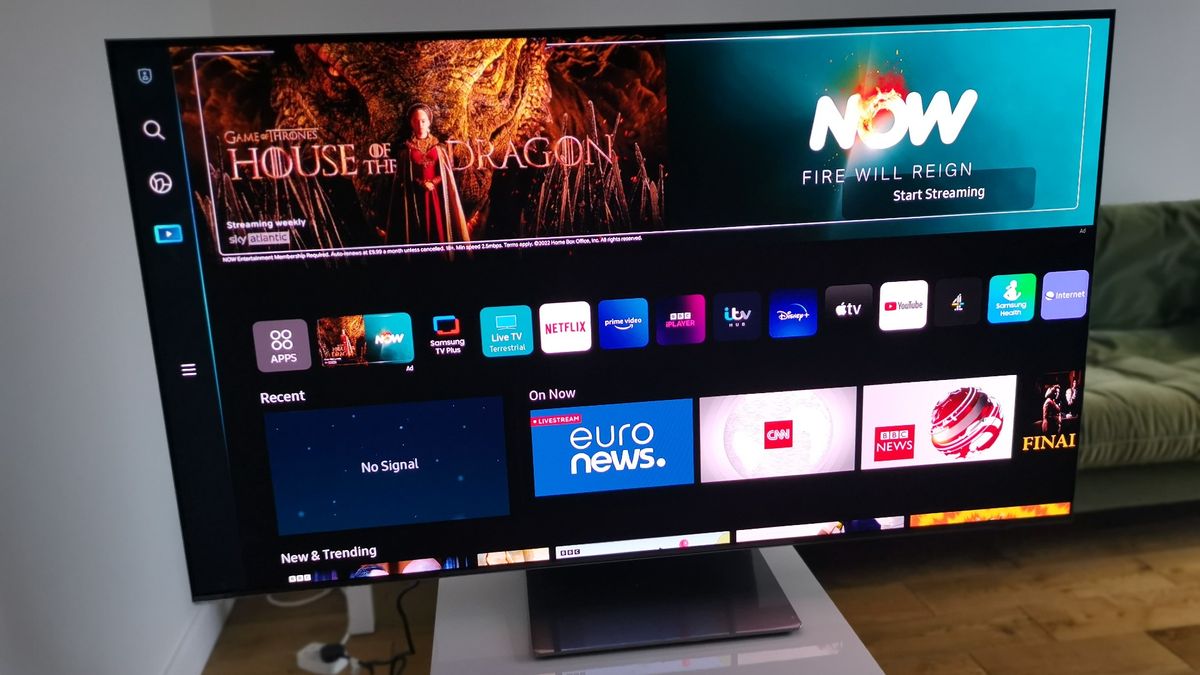12DOVE Verdict
The Samsung S95B is a QD-OLED panel that combines class-leading brightness with solid gaming support and a rock-solid smart platform - but subtle it is not…
Pros
- +
Bright room OLED performance
- +
Low input lag
- +
Tizen smart platform
- +
4k 120 fps support and great for gaming
Cons
- -
No Dolby Vision
- -
Can be fatiguing to watch
Why you can trust 12DOVE
This is OLED, but not as we know it: the Samsung S95B uses a QD-OLED panel, newly developed by Samsung Display that marries OLED’s traditional benefit of inky blacks with the expanded colour volume offered by Quantum Dot technology. What results is a brighter, more vibrant OLED display. The technology is a direct competitor to LG’s OLED.EX initiative (as used by LG, Panasonic, and Philips); and it’s also an intriguing alternative to Samsung’s own QLED models.
Of course, there’s more to the S95B than just its glass. The set also boasts excellent gaming connectivity and performance, and a superior smart platform. Let’s dig a little deeper to see if it can take on the best gaming TVs and best TVs for PS5 and Xbox Series X...
Features & Design
Eye-catchingly slim, Samsung describes the design of the S95B as 'LaserSlim' and that doesn’t seem far off the mark. The panel looks a little fragile, and handling the thing is a bit nerve-wracking, but the silver metallic back adds welcome rigidity. With a next-to-non-existent bezel, the screen sits on a neat, squared-off metallic pedestal.
All connectivity is built in (Samsung seems to be winding down production of its One Connect external interface box) and that means you get four HDMI inputs, all v2.1 enabled and able to handle 4k 120fps sources on the back. Supporting this spec - which already makes it a great contender for inclusion on our best 120Hz 4K TV guide - there’s also VRR (Variable Refresh rate) with NVIDIA and AMD FreeSync support, plus ALLM (Auto Low Latency Mode) and eARC. You can use the latter to route a Dolby Atmos bitstream to an external soundbar or AV system, while there's also a trio of USBs, digital optical audio output, and Ethernet to support Bluetooth and Wi-Fi.
The TV comes with a solar-powered remote, which should save on batteries in the long term, as well as a standard control wand.

As you might expect, Samsung’s Tizen platform provides the user interface and handles all smart connectivity. It’s had a modest update this season, which has done little to simplify navigation, but it does showcase the amount of content on tap.
The main home screen has a side menu offering Search, Ambient, Game, Media, and Menu buttons. The Ambient button offers a variety of art content and soothing videos, such as fireplaces and food, and if you select Media you'll be taken to the homepage and a wealth of streaming and catch-up apps (Netflix, Prime Video, Disney+, AppleTV+, BBC iPlayer, and more), Samsung’s own TV Plus IP delivered channel service, and interoperability with SmartThings connected devices.
Samsung’s Game Hub interface offers unfettered access to any connected games console or streaming service and puts the TV in Game mode. Latency for gaming is good, too: we measured input lag at 9.6ms (1080/60) with Game mode selected.
Performance
The S95B effectively rewrites the OLED rulebook when it comes to picture performance. Our default expectation for any OLED is perfect black, with variable low-level shadow and pronounced dark room dynamics. This QD-OLED debutant changes the game with a consistently high level of brightness. You won’t feel the need to game with the lights low for the best image quality. Samsung has also gifted the set with a Neural Quantum Processor, able to apply AI techniques that enhance images in real-time and improve HD upscaling.
There are points of contention though. There’s still no support for Dolby Vision, which is a definite pain point for film fans. What we do get is HLG, HDR10, and HDR10+ compatibility. That said, the set’s HDR performance is remarkable for an OLED panel. We measured peak HDR in excess of 1400 nits using a 5 percent window.
To make life easy, the set’s Neural Quantum Processor has an AI-driven Optimization mode that analyses content along with the viewing environment and adjusts picture characteristics accordingly. This saves having to meander amongst the menus to get the best picture, regardless if you’re watching drama or sport. If you disable this Intelligent mode, all the standard Samsung picture preset options become available. These comprise Dynamic, Standard, Movie, and Filmmaker modes. We’d advise you to steer clear of the Dynamic setting as it’s too over-saturated, roasting skin tones. Standard is the way to go, when not relying on AI, as colour gradations are smooth, and banding isn’t an issue.

Perhaps more disturbing is that the set’s bold hues also impact the Game mode, making onscreen action look a little cartoony. Call of Duty Warzone looks like something out of Looney Tunes. On the plus side, however, 4K 120fps playback is buttery smooth.
You might be forgiven for thinking a set as thin as this would fail on the audio front, but it’s actually rather impressive. The rear-mounted ‘back-pack’ actually has dedicated height, width, and centre drivers, and together they make a rather acceptable presentation. There’s ample volume too - the system is rated at 40W - and those ‘height’ drivers add to the set’s wall of sound effects.
The aforementioned Intelligent mode setting can be filtered to include audio processing, such as Active Voice Amplifier, Adaptive sound, and Adaptive Volume. The Voice Amplifier monitors noise in your viewing environment and adjusts TV audio so that dialogue is always clear. Adaptive Sound adjusts the audio based on environmental noise.
However, this isn’t a screen that offers immersive audio built-in, so it’s worth thinking of adding a soundbar or separate audio system when funds allow. The set can be paired with Wi-Fi surround speakers, however, none were supplied. The S95B supports Q-Symphony when paired with a compatible Samsung soundbar, so that’s an easy performance upgrade.

Overall - should you buy it?
If you’re after a high-spec OLED TV with class-leading gaming credentials, the Samsung S95B is well worth shortlisting. Its nearest competitor is the LG C2, and it comfortably outshines that model when it comes to peak HDR brightness.
This inherent brightness won’t please everyone though (subtle it is not), but if you’re largely planning to use it in a brightly lit room rather than a batcave, it’s consistently entertaining. We rate it well worth considering if 4K 120fps gameplay is a must-have.
How we tested the Samsung S95B
Obviously, as the first QD-OLED OLED screen from Samsung, we were keen to test both its traditional OLED qualifications, and the benefits of that Quantum Dot-powered brightness. We watched a plethora of content in both dark and bright room living conditions, with a particular view to see how it coped with darkly lit sequences in fantasy epics, brightly lit animation, and fast-moving sports.
HDR performance was measured using industry-standard test patches at both 5 and 10 percent sizes, while tried and tested Dolby Atmos test clips challenged the set’s audio prowess. Samsung’s Tizen smart platform was checked for smart app availability and catch-up TV provision. 4K 120fps gameplay was assessed with some prolonged sessions of Call of Duty Warzone.
The S95B is one of 2022's best bits of tech for gaming - why not browse other top gear in the shape of our guides to the best PS5 SSDs and best PS5 headsets, as well as the best Xbox Series X headsets, and best Xbox Series X hard drives to round out your setups.
Steve May is a home entertainment technology specialist. Creator of Home Cinema Choice magazine, Steve writes about gadgets and gizmos for GamesRadar, T3, Louder Sound, TechRadar, Home Cinema Choice and Yahoo. He’s also the editor of The Luxe Review and Pro AV site Inside CI. Steve once wrote a games column for legendary British comic 2000AD (and has a badge to prove it), and maintains that when it comes to top shooters, Doom is the GOAT.

Metaphor: ReFantazio wanted to fix the JRPG grinding problem, but Atlus went too far at one point and accidentally broke the whole combat system

Final Fantasy 7 Remake and Rebirth battle director says combining everything he learned on Monster Hunter: World with Square Enix's technology and unique skills created a "chemical reaction"

"Minutes after Palworld released," Pocketpair was already getting game pitches from "some really big names" before it even set up its own publisher: "No one has money at the moment"












